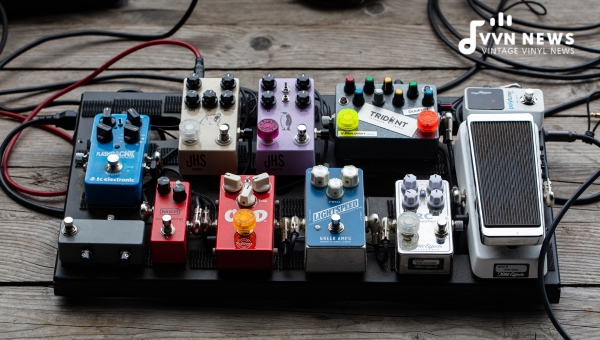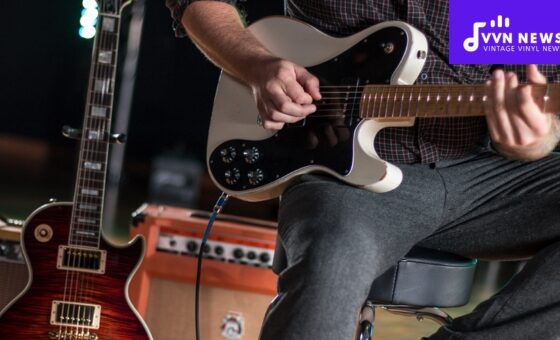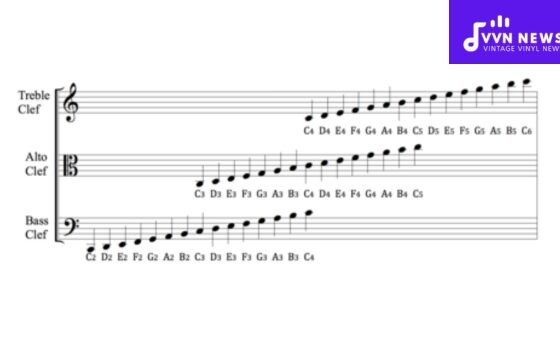Ever plugged into your pedalboard to find your sound isn’t quite hitting the sweet spot? I’ve certainly been there! Your darling stompboxes are more than just individual effects; they also interact with one another to culminate in your unique sound.
That’s where understanding the intricacies of ‘guitar pedal order’ plays a pivotal role. More than just an arrangement, the proper order can be a make or break if you’re searching for that perfect tone you’ve always fantasized about.
This guitar pedal order matters! – the signal chain & effects loop guide is going to deconstruct the logic behind routing your pedals effectively and will alleviate common confusion about why and how placing pedals in certain orders can resultantly augment or diminish your overall tone.
This guide won’t solely help fine-tune your playing, but, at its heart, it empowers you to take full command over shaping and controlling what eventually comes out of your amps. Let’s uncover the secrets to hitting that sonic sweet spot, shall we?
What is a Guitar Signal Chain?
The guitar signal chain, often referred to as the effects chain, defines the series or ‘chain’ through which your guitar’s signal will flow from one pedal to the next before it eventually makes its way out of your amplifier.
When you strum a chord on your guitar, the raw tone is referred to as ‘dry’. As it traipses through each pedal in your setup, that signal is manipulated, enhanced, and shaped, producing an augmented ‘wet’ tone.
Why Does Guitar Signal Chain Matter?
To put it simply, the guitar signal chain can drastically alter your ultimate output. The manipulation of the ‘dry’ signal is very much dependent upon the type of pedals being used and equally importantly, their order in the chain.
A shift in the order or position of a pedal could either benefit your sound or cause unwanted interferences. Pedals interact with each other, amplifying certain traits or conflicting with others. For example, if a reverb is placed before distortion, you may lose the tail-end of that reverb sound as distortion tends to compress signals.
Also Read: Guitar Strings Guide 2025 [How To Choose Guitar Strings]
Rules for the Guitar Effects Order: The Comprehensive Breakdown
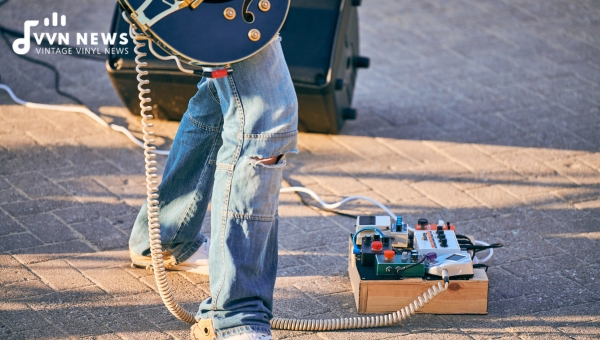
We all know that with great power comes great responsibility, and the same goes with guitar pedals. They are our sonic weapons, empowering us to mold our sound in any tonal direction we fancy.
However, without a deep understanding of how to order these wonders of technology correctly, we might just end up in a disarrayed labyrinth of sounds and tones.
The Logic Behind Effects Groups Order
By understanding the core logic behind guitar pedal orders, you get the upper hand in wielding the power of your effects arsenal effectively. As with most things concerning sound, the order, too, is dictated predominantly by nature and physics.
Essentially, your signal chain starts with dynamics, such as compressors, and expands, leading to filters and pitch shifters, then to gain stages influencing amplitude and distortion.
Next comes modulation, like chorus or tremolo, and finally, those impacting times, such as echo or reverb. Adhering to this order as a blueprint can dramatically enhance your sound by harnessing the inherent way pedals affect one another within this sequence.
Experiment among the Groups
Experimentation has always been the heart and soul of music. While it’s beneficial to comprehend the conventional arrangement logic, remember that rules are merely there as guidelines.
Feel free to fiddle within effect groups—maybe you prefer your tremolo before your reverb or vice versa—and discover what unique sonic amalgamation you can concoct!
Technical Variables Influencing Pedal Order
Although applying this sequence is impactful alone, considering other technical variables should drastically enhance your results.
Certain stompboxes may contain buffers that alter impedance and can mingle unexpectedly with others; some units don’t ’play nice’ together due to design differences; particular fuzz units hate seeing anything but the pure guitar signal before them—the list goes on!
Each arsenal is remarkably unique with different pedals interacting distinctively based upon their designs. Therefore, remember that while this guide presents a solid starting point for arranging your pedalboard effectively—the eventual secret sauce lies in experimentation personalized towards your gear.
Featuring physics-based order balanced alongside flexible experimentation allows you to maximize your possibilities while ensuring foolproof functionality in achieving terrific tones effectively through wisdom-steeped pedal orders!
Also Read: 15 Best Guitar Tuners Of 2025 [Expert Choice]
The Correct Guitar Pedal Order
Making sense of the myriad options in guitar pedal order can seem bewildering at first. However, there’s a logical sequence that you can use as a guide to set up your pedals effectively.
Dynamics
Generally, dynamic devices like compressors and equalizers (EQ) are placed first in line. This is because these effects shape your raw guitar sound directly, maximizing their effect before it gets distorted or modulated by other pedals.
Compressor: Smoothens out the dynamic range of your signal by boosting quiet sounds and tamping down loud ones.
EQ: Adjusts specific frequency bands within your sound, allowing you to sculpt your tone precisely.
Filters & Shifters
These stompboxes, notably wah-wah and pitch-shifting pedals, usually follow dynamic devices. As frequency-based effects, they’re more effective when applied directly to your adjusted signal.
Wah: Creates a sweeping filter effect.
Pitch Shifters: Alter the pitch of your instrument’s signal, creating harmonies or octaves without changing your playing.
Gain
Gain-based pedals, like distortions and overdrives, reside comfortably after filters and shifters in the chain. Inserting them, post-EQs can further accentuate the enriched signal from these pedals.
Distortion/Overdrive: Adds an unmistakable gain-driven edge or “grit” to enhance the tone of the character.
Modulation
Here, lie effects such as choruses, phasers, or flangers applied post-gain-based effects. Their sonic swirls ornament not just clean tones but also enjoy flirting with gritty ones!
Chorus/Phaser/Flanger: Enriches the signal by adding texture and depth—creating lush sonic landscapes viewable by ear!
Time-Based Effects
Last but certainly not least, in our chain are time-related effects—a domain typically housing units like delay or echo units alongside illustrious-sounding reverb tanks—they thrive on feasting upon an amalgamated mix rather than hungry raw signals.
Delay/Echo: Applies repetitions to your playing with varying delay times—resulting in anything from a rockabilly slapback echo to ethereal ambient cascades.
Reverb: Adds spaciousness to your sound—as if you’re playing anywhere from booming cathedrals to tight bathroom stalls (!).
In essence, this sequence lets you go from shaping your core tone all the way up to adding finishing touches with spacious echoes or reverbs, delivering tantalizing tonal goodness directly from fingertips to ears!
Also Read: What Is Reverse Reverb [How To Create Backwards Echo Effect?]
What are Pedal Groups?
Pedal groups essentially refer to the categories into which various types of effect pedals fall. Classifying pedals into these clusters is primarily based on the function or sound alteration they perform in your total signal chain.
Dynamics – includes pedals that alter the volume of your signal or shape its tone, such as compressors, limiters, volume pedals, and EQs.
Filters & Shifters – consist of wah-wahs, envelope followers, or pitch-shifters that modify frequency content within a signal.
Gain Stages are home to all your overdrive, distortion, and fuzz pedals used to clip or saturate your guitar tone.
Modulation Effects like phasers, flangers, and choruses add richness and body to the signal by creating periodic changes in level/frequency/phases, etc.
Time-based effects, including delay and reverb units, add space and atmosphere to your overall tone by mimicking natural echoic environments.
In diverting from standardized pedal orders, you’re essentially intermixing these pedal groups— leading to some fascinating sonic texture!
What Does This Pedal Order Offer?
The prudent arrangement of guitar pedals in the correct order acts as the secret key to unlocking your dream tone. It allows each pedal to perform and add its value at the respective ideal points within your signal chain.
- Tonal Integrity: Maintaining the appropriate order ensures that your guitar signal is processed, modified, and shaped without losing its essence till it finally reaches your amp.
- Harmonic Richness: It helps to create a multi-layered symphony of effects—making your sound fuller and richer.
- Noise Control: Proper ordering can minimize undesirable noise interference between the pedals.
- Dynamic Flexibility: It allows you better control over turning on and off, stacking, and combining multiple effects for an infinite array of sounds.
Discovering ‘your’ colossal tone is all about playing around with this order until you find what fits perfectly within the jigsaw puzzle that is your musical expression!
Pedals Order Setup Examples

Setting up the pedals in your guitar rig correctly can greatly enhance your playing experience. Below are a few examples of pedal order setups
Noise to Reverb
Starting with the guitar moving into a Noise Gate, we arrest unplanned noise and feedback. A Compressor follows the next, evening out audio signals before they go any further.
The Equalizer (EQ) comes next, allowing for specific frequency band adjustments, which are particularly useful for defining your sonic character. Fuzz drops in as our first gain stage serving up warm, vintage distortion adding body and sustain to your tone.
Following the Fuzz, we introduce both Chorus and Tremolo, our modulation effects responsible for contouring your sound with lush depth and rhythmic pulsations, respectively. We conclude with Reverb mirroring the ambiance of physical spaces before signal hits the Amplifier.
Guitar > Noise Gate > Compressor > Equalizer > Fuzz > Chorus > Tremolo > Reverb > Amplifier
The Post-Amp Looping Setup
The initial order remains comparative to the previous. However, post EQ we send a boost-enhanced signal to Amp! Then enter Vibrato and Flanger—two beautifully-textured modulation units—situated post-amplification instead (in the Amp’s FX loop).
This setup lets you gain advantage from your amp’s own tone coloring before contouring it further with these effects!
Guitar > Compressor > Equalizer > Pitch Shifter > Boost > Amplifier (Send) > Flanger> Vibrato> Delay> Reverb> Amplifier (Return)
The Spacey Fuzz Experience
Starting off with Wah for some fluidic tonal sweeps followed by compression & EQ; we introduce Distortion early on for some edge on our raw signal.
Octaver drops in here, adding an entirely new sonic layer all before introducing Flanger coming right into Delay and closing with huge spatial soundscapes thanks to roomy Reverb.
Guitar> Wah> Compressor> Distortion> EQ> Octaver> Flanger> Delay> Reverb>Amp
Subtle Ambient Background
A different approach where compressors iron-out those volume spikes after an EQ has shaped our frequency spectrum; adding fuzz-flavored body pre-chorus that twirls rhythmically around obtained tonality while volume pedals emphasize dynamics right before two giant spatial captains of time-Delay & Reverb commence play.
Guitar > EQ > Compressor > Fuzz > Pitch Shifter > Chorus > Volume > Delay > Reverb > Amp
Pronounced Sonic Sketches
This board begins with Phaser effect known for its undulating tonal shifts set up prior to gain stages leading into Overdrive, after which modulation effects are dialed down considerably, limiting themselves only to volume dynamics yet unveiling profound soundscapes thanks to heavy use of delay & reverb, ensuring unique musical sketches are portrayed every time.
Guitar > Phaser > Reverb > Delay > Fuzz > Compressor > Volume > Overdrive > Amp
The beauty of these pedal orders lies in their adaptability depending on individual style. You’re just a stomp away from crafting magical sonic portraits within boundaries drawn by physics & technology yet colored by creativity & experimentation!
Also Read: How Does A Guitar Tone Knob Work? 2025 [Practical Guide]
What is an Effects Loop?
An effects loop, simplified to its core, is a pair of ports (send and return) on an amplifier aimed at the facilitation of sound effects coming through the same.
It primarily allows you to place certain guitar pedals between your amp’s preamp section (the spot adjusting your EQ and adding gain) and the power amp section (that takes said signal and transforms it into something powerful enough to drive the speakers).
Now, why would this be interesting or useful? That’s because certain sound effects can serve to sound infinitely better when placed after the initial distortion or overdrive provided by an amp’s preamp section.
Let’s elaborate through an example— Time-based effects like reverb or delay might become too cluttered or extreme if introduced before distortion as opposed to after.
The effects loop serves this exact purpose: enhancing clarity and reducing noise by correctly inserting these effects after any inbuilt amp distortions.
What Does This Effects Loop Offer?
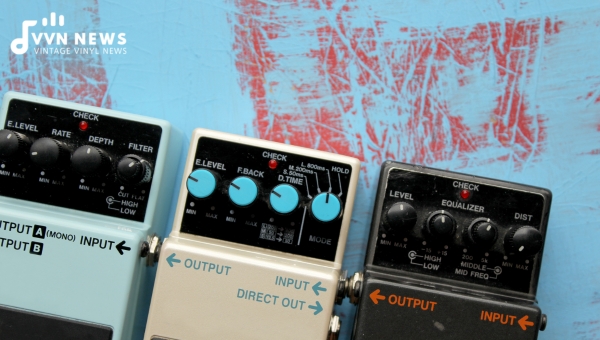
Effects loops offer you complete tonal supremacy towards generating exceptionally premier soundscapes tailored to perfection. Let’s see how:
- Augmented clarity in your time-based effects
- Greater control over your tonal mix from different pedals
- Overall reduction in signal noise
- Improved adaptability towards different scenarios
- Enhanced utilization of all stompboxes at your disposal!
The web of possibilities opened up by using an efficient pedal order with a competent effects loop is vast — enabling iconic tones via correct balancing provides pivotal benefits for tonally adventurous guitarists everywhere!
Guitar Pedal Effects Loop Setups Explained
In effect, the effects loop exists as a separate signal path, most commonly found in amplifiers.
It operates between your pre-amp and power amp sections. Notably, this routing technique presents an exceptional advantage where modulations do not encounter the gritty pre-amp signal.
Let’s dive into some key examples:
Setup 1
Dynamics (Compressor), Filter (Wah), Drive (Overdrive), Pitch, Modulation (Chorus), Volume, Time (Delay & Reverb).
Under this configuration, we feature dynamics and gain effects (compressor & overdrive) along with a filter (wah) before injecting the signal into the amp.
Following this, modulation and time effects (chorus, delay & reverb) are linked through our effects loop. Here, they respond to a cleaner amp signal – advantageous for preserving the clarity of these delicate effects.
Setup 2
Dynamics (Compressor), Filter (Wah), Drive (Overdrive), Pitch, Modulation (Flanger, Phaser, Chorus), Volume, Time (Delay and reverb).
Quite similar to setup 1, only our modulation extends with flanger and phaser chains in the loop path, further enriching our sound.
Setup 3
Dynamics (Compressor), Gain adjustment (Volume pedal), Filter (Wah pedal), Drive (Fuzz), Modulation (Chorus), Time effects (Delay and reverb).
This time, we introduce fuzz into our list of pre-amp units. Our chorus disruption now precedes delay/reverb since it’s positioned prior to hitting ‘send’.
Remember that these setups purely exist as guidelines. Feel free to personalize them – experiment with different sequences and stompboxes according to your pedals’ unique tint and interaction tendencies! This flexibility is what makes crafting an esteemed personal tone such an exciting venture.
What are Multi-Effects Pedal Setups?
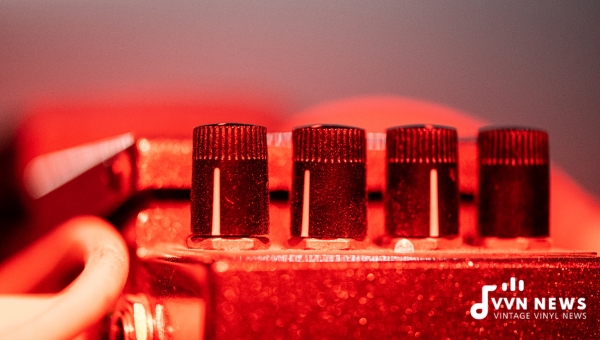
A multi-effects pedal setup involves the use of a single device that houses numerous effects. These versatile units can contain dozens of different types of guitar effects, and many offer the capability to combine effects in any order you prefer.
The design lets you discover and experiment with new sounds or emulate the tone of your favorite guitarists without having to invest in multiple individual pedals.
What Does This Multi-Effects Pedal Setup Offer?
With a multi-effects pedal, convenience is definitely at the forefront. Imagine having an entire pedalboard condensed into a single stompbox – hectic setups and tear-downs are virtually eradicated. Plus, there’s no more fretting over power supplies or patch cables!
A multi-effects pedal can also be extremely cost-effective. Instead of investing lump sums into individual pedals, you get an assortment of tonal options in one go.
Furthermore, many multi-effects units come with built-in editable presets to recall your favorite settings instantly—a lifesaver for gigs and studio sessions!
However, all these benefits don’t mean there’s no room for other pedals. In fact, integrating your choice multi-fx unit within our guide’s idealized order could yield highly unique and diversified soundscapes.
It provides the best all-around solution for tonal diversity, convenience, and user-friendliness! Multi-effects pedals cater to both seasoned players seeking versatile soundscape possibilities as well as beginners looking for an easy entry point to the world of guitar effects.
Also Read: How To Play Guitar In 2025? [A Beginner’s Guide]
Multi-Effects Pedal Setups and Examples
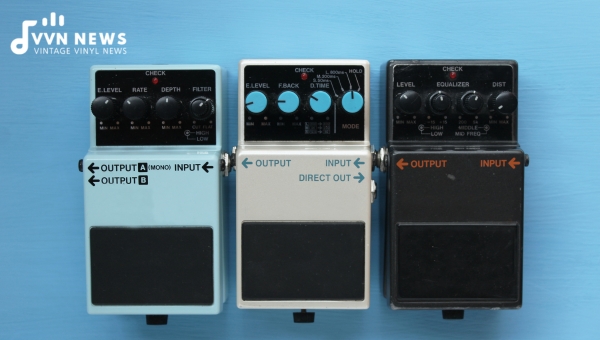
In the world of guitar pedals, a common predicament faced by us, the guitarists, is choosing between individual stompboxes and multi-effects units. However, I’d like to reiterate—it doesn’t have to be an either-or scenario.
Melding individual effects with multi-effects units can curate an expansive tonal range versatile enough to emulate your wildest sonic dreams.
Example 1
Guitar > Compressor > Volume > Wah > Multi-FX > Chorus > Phaser > Delay > Reverb > Amp
This setup places the multi-effects unit directly after the ‘Dynamics’ section. Your compression and volume signals are shaped prior to entering the multi-FX unit.
You can tessellate your favorite effects within this pedal, such as overdrive or distortions, hence granting you refined control over your gain stage.
Post-multi-FX, your modulations in terms of chorus and phasers induce a warm modulation prior to being further colored by time-based delay and reverb before final amplification.
Example 2
Guitar > Multi-FX> Volume > Overdrive> Wah > Octaver> Chorus> Delay> Reverb> Amp
Rather unconventionally put upfront, this approach caters admirably for early equalizers or compressors within the multi-FX pedal.
The subsequent volume pedal is followed by gain-stage overdrive creating large degrees of sonic flexibility by infusing these enhancements within pitches (thank you, Octaver!) and emulating sweeping envelopes via the grand old Wah!
Example 3
Guitar > Compressor> EQ> Wah> Overdrive> Multi-FX> Volume> Delay> Reverb> Amp
Positioning your Multi-FX post-gain stage but prior time segment permits you to assign additional switchable distortions/overdrives/fuzz within, along with tuneful modulations! This provides another layer of powerful dynamic control.
Evidently, your multi-effects command isn’t confined to a single niche amidst your sequence but thrives upon innovative experimentations respecting physics-based logic while infusing layers of creative manipulations celebrating flexibility.
Remember, modifying orders is an organic part of capturing individual tonal nirvana; in fact Arthur Schopenhauer didn’t say for nothing—talent hits a target no one else can hit; genius hits a target no one else can see.
Also Read: How To Build Guitar Calluses? 2025 [How To Avoid Finger Pain?]
FAQs About Guitar Pedals Order
Why does the order of guitar pedals matter?
The sequence of guitar pedals can drastically shape your sound output. The output of each pedal in your chain influences the input of the pedal following it, hence the order matters.
What is a signal chain in terms of guitar pedals?
Signal chain refers to the order in which your guitar’s signal passes through different effects units or pedals. This sequence can shape and color your overall sound dramatically.
If I ignore these guidelines, will my sound be awful?
Not necessarily, as creative usage can lead to unique tones. But for clarity and consistency, sticking to tried-and-true pedal order guidelines is advisable.
What is an ‘effects loop’?
An effects loop allows some pedals to be inserted after an amplifier’s preamp stage but before its power stage. It ensures cleaner, uncolored sounds from modulation and delay effects by avoiding overdrive/distortion effects.
Can I put all my pedals in the effects loop?
Yes, however, usually only time-based and coloration effects like delay or chorus yield optimal sounds via an effects loop. Drives/distortions should ideally go upfront.
Conclusion
Guitar pedal order truly matters! Understanding the signal chain and optimizing the effects loop is crucial to wielding your sonic arsenal effectively.
Adhering to standard practice while also daring to experiment within each group enables you to mold unique tones directly reflecting your musical personality.
Remember, rules are just a starting point. Your creative intuition, coupled with structured understanding, will be the key ingredients behind finding that perfect sweet sound spot!
